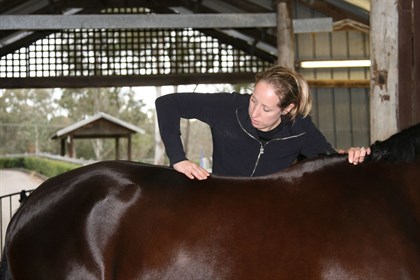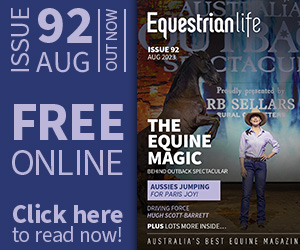
A hands on assessment can give a deeper understand to your horses physical limitations. Image: Emma Mathlin.
Let's get physio!
By Emma Mathlin
When you and your horse work together, you become a single unit. If one of you is not up to scratch, it’s time for a physiotherapy assessment of both horse and rider.
Horse and rider are an athletic team where one affects the other. We know that a rider’s asymmetry can cause back pain and lameness in the horse, and issues in the horse can cause pain and dysfunction in the rider. Therefore it is important to look at the whole partnership, both separately and together, to improve performance and reduce the risk of injury to horse and rider.
A physiotherapy assessment of the rider encompasses addresses many areas of the body. Image: Emma Mathlin.
Physiotherapy is defined as “the assessment and treatment of movement dysfunction and musculoskeletal injury and disease”. An equine physio must train for at least four years as a human physio before undertaking extra study to work with horses. In most states in Australia it is a legal requirement that all equine physios work with consent from your vet. This ensures that a full diagnosis has been made and the treatment provided to your horse is safe and effective. Physios work closely with not only your vet, but also with your farrier, dentist, coach and other health professionals. This team approach assists in achieving the best possible performance outcomes.
A separate assessment of horse and rider followed by ridden evaluation may be useful if:
• You and/or your horse performs better on one rein over the other.
• You feel uneven in, or lose, one stirrup.
• You sit unevenly in the saddle.
• You or your horse have pain.
• You want to improve your performance!
Part of a physiotherapy assessment for your horse comes in the familiar form of the “trot up”. Image: Emma Mathlin.
RIDER ASSESSMENT
The aim of an off-horse assessment is to highlight and address any asymmetries (differences from left to right), postural faults and movement dysfunctions you have in the saddle, in order to provide treatment solutions to address any areas of weakness.
Standing symmetry can be assessed by standing with each foot on a separate set of scales – is there equal weight in each leg? Also, are the shoulders and hips level?
Your physio may then look at the range of movement in different areas of the body. Can you achieve the required position in the saddle and can you move with ease? We know that it is important that riders have good ankle, hip and thoracic spine (between the shoulder blades) mobility.
Tests such as a single leg bridge and single leg squat can identify muscle weakness and deficits in stability.
Your horse is an athlete, and we must support his physical demands. Image: Emma Mathlin.
HORSE ASSESSMENT
Your horse is an athlete and is susceptible to similar types of musculoskeletal injury as human athletes are. The principles of physiotherapy for your horse are the same as for people – the assessment and treatment of movement dysfunction, muscle imbalance, stiffness, weakness and adaptive changes in soft tissue and joints.
The posture of this horses and rider is highlighted by the angles they present. Image: Emma Mathlin.
An equine physio will first want a full history on your horse. Does the horse have any previous history or has been treated by a vet or physio before? They may also ask you questions about your horse’s behaviour, tack, shoeing, teeth and schooling.
Then they will watch how your horse moves – is he symmetrical? Is he sound? This can include looking at walk and trot in a straight line and then on a circle, backing up, turning tightly and using a variety of surfaces. Some types of lameness and movement problems may only become apparent with circles or on a different type of surface.
After watching your horse move, your physio will then perform a thorough hands-on assessment, which may include looking at posture and muscle bulk, joint range of motion, palpation of the soft tissues, the ability to round up and extend the spine, balance and accepting weight transfer through the limbs.
A front on view can give a new perspective. Image: Emma Mathlin.
PARTNERSHIP ASSESSMENT
The physio will look at how the horse moves under saddle – is this different to how he moves in hand? Are the rider’s identified weaknesses from the off-horse assessment displayed in the saddle? Video analysis and specialised biomechanics software can assist in analysing posture and movement of the horse and rider.
A standing assessment can highlight postural and positional faults. In this photo we note the rider’s head is tipped forward and this is matched by the horse’s head position being behind the vertical. The rider’s heel is slightly up, making the ankle joint not flexed enough. Looking from front on demonstrates this rider’s left leg is more rotated outwards than the right.
Visual and video assessment of walk, trot, canter and other special movements will complete the full picture and allow the development of a treatment plan to improve the performance of you and your horse.
If you are interested in finding out more about horse and rider biomechanics clinics, go to www.equimotion.com.au
READ THE LATEST NEWS ARTICLES HERE
https://www.equestrianlife.com.au/articles/Lets-get-physio_

